The Opuwo airstrip had to be cleared of goats before our Beechcraft turboprop could put down on it. The presence of an airplane at all was unusual enough to draw a crowd of spectators to the landing. As the propellers spun down, dust settled around a waiting convoy of overland-kitted 2020 Land Rover Defenders. I still wasn’t sure how the vehicle would handle real off-grid off-roading, but we were going to find out.
(Full Disclosure: Land Rover spent a fortune organizing eight waves of test pilots, including myself, to come to Namibia and see what the Defender could do on an epic expedition. Seriously, it must have cost well over $10,000 per head to execute this.
The trip took place in February of 2020 before the coronavirus was considered any kind of travel risk for the general public.
Also, if you want to skip storytime and just get my take on the vehicle, scroll to the “The Defender” subheading.)
On a map of Namibia, Opuwo is the last dot in the upper-left corner between the Angolan border and Skeleton Coast on the Atlantic Ocean, about a 500-mile drive from the country’s largest city (Windhoek: 431,000).
Northwestern Namibia’s terrain ranges from harsh to assaultively desolate. There’s a lot of scrubland, just rocky ground with sparse trees, then huge tracts of severe nothingness. It’s lovely too, in its own way, leaving you with an elevated appreciation for solitude and silence.
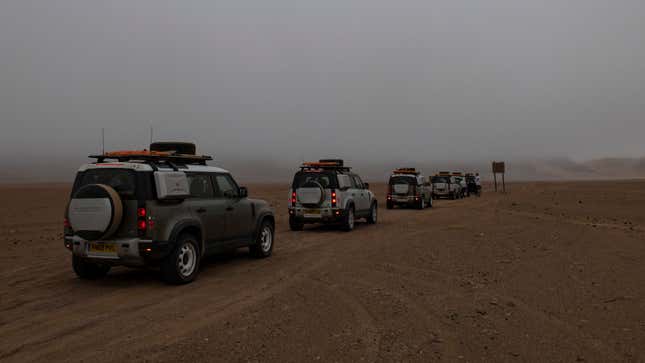
This region is known as Kaokoland, and well worth the challenge it takes to reach and run through, a perfect place to test a Land Rover Defender.
The Expedition
From Opuwo, our convoy of about a dozen Defenders ran north into an area populated mostly by semi-nomadic pastoral people on roads lousy with sharp rocks and excitable ostriches.
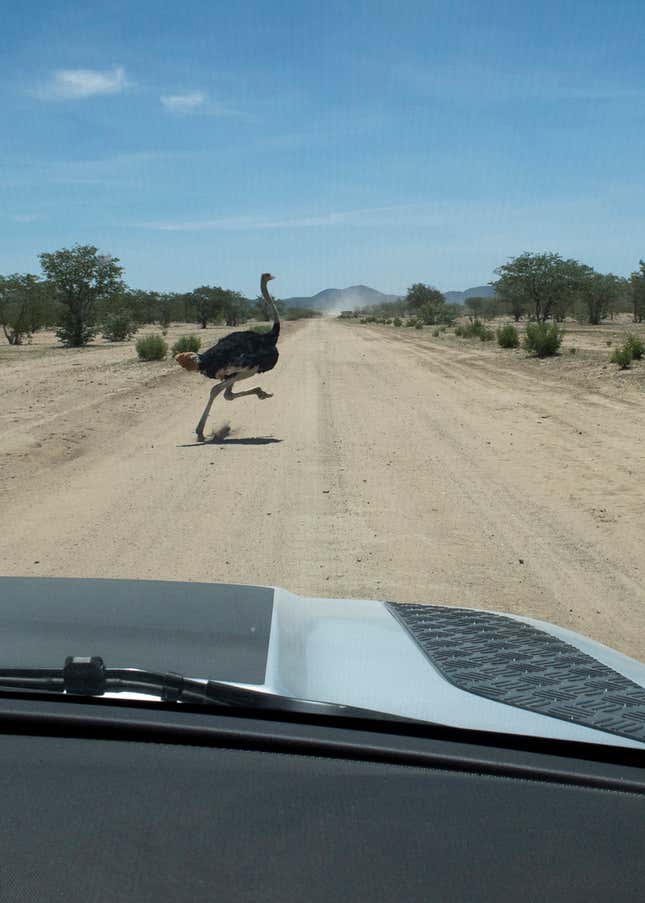
If you’ve never seen an ostrich run, friends, two things to understand: These are large animals much bigger than a grown man, and they can cover a car length in two strides. Watching their spindly legs propel their plump bodies is quite a head-scratcher. It looks like it shouldn’t be possible.
In addition to speed and substantial size, ostriches have claws that will end you like a mackerel on the deck of a Gloucester charter boat if they feel like you’re threatening their family.
“Oh, yeah, ostriches are big and fast,” Overland Journal CEO Scott Brady said to me, as two of these fluffy flightless birds sprint-skipped across the path of the Defender we were driving.
I grabbed a bootful of brake which reeled the 4x4 right in, but unnecessarily. The ostriches were already in bushes on the other side, almost completely obscured by greenery. “Lions won’t even tangle with them, usually.”
Luckily for us, ostriches are generally not aggressors against humans. So if you meet one, give it some space and you should be just fine. That’s another nugget I got from Mr. Brady.

Brady is a known individual in the overland community, heading up the company that produces the beautiful Overland Journal magazine and authoritative Expedition Portal forum. As you might guess, he’s well-traveled and an above-average driver. He’s also a friend of mine, so it was fun to spend a few days sharing a rig from him and hearing his insights on vehicular travel in general.

Night one, we made camp not far from an unoccupied neighborhood of huts made of sticks and mud. The people who live in the region are often on the move, following viable food sources for their livestock as that changes over the course of the year.
John Kasaona, a conservation leader from the area, joined us there and explained a little bit about how his organization, the Integrated Rural Development and Nature Conservation, is working to protect Namibia’s animals and enrich the lives of its human residents.
The IRDNC faces some challenging issues, including educating a uniquely geographically distant population and trying to optimize human/wildlife relationships. If you’re more curious about that outfit’s work, check out its page or Kasaona’s TED Talk.
Around the campfire, he shrugged off the rugged roads and long driving distances as part of life. Having seen some ancient running pickup trucks scattered around the scrubland, I asked where the Kaokolandians get gasoline or diesel.
“One might go into town every now and then, come back with a lot.” Kasaona was sparing with words but said that he himself spent a lot of time driving between villages. Looking over at one of the automaker executives, he added: “If I had a Land Rover,” with a laugh, “I would be much more comfortable.”
I didn’t see many vehicles at all on my brief stint in Kaokoland, but the rigs I did see were either decades-old pickups, rental Land Cruisers, or, yes, older Defenders.
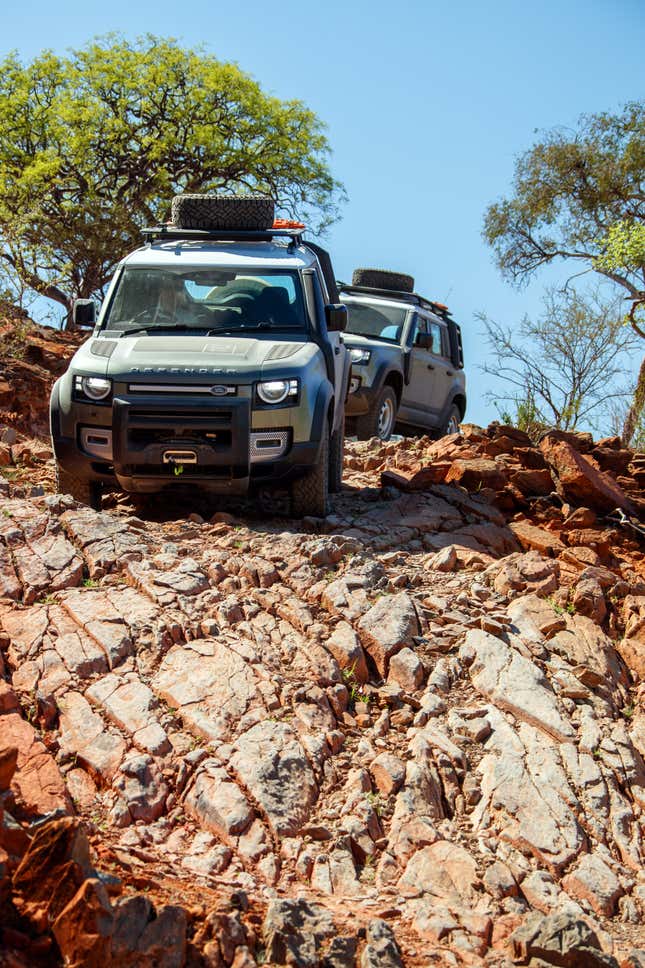
Our own logistical mission seemed easy in comparison to Kasaona’s job–our Day Two objective was just to follow the GPS line down Van Zyl’s pass.
“This is a place people know about,” Brady told me as we powered out of a dry riverbed and begun our descent. “Van Zyl’s is no joke.”
Indeed. The joint’s a skinny, slippery, steep track named after Dutchman Ben Van Zyl who apparently cut the current route in the ’60s with a Chevy truck, a tractor, and a lot of laborers.
I’ve also seen some less-cited reports that the trip was done in the 1920s with a Model T, but frankly, it’s still harrowing in 2020 and I’d be wary of even attempting the drop solo if I came across it in my own wanderings, no matter what I was driving.
On this intimidatingly unforgiving downhill crawl, the Rover’s low range and rock mode did a great job keeping wheel speed extremely low without dragging brakes and causing skidding.
Though we did pop wheels off the ground a few times, steady forward progress was maintained thanks to gravity, gearing, and traction control.
On the other side of the pass, our Defenders transitioned into a wide-open sun-scorched flatland called Marienfluss where we could put the hammer down and sail over heavily corrugated desert tracks.
As our control arms, ball joints, shocks, and axles were relentlessly pummeled by the earth I had a realization: The ride was almost as smooth as bathwater.
In this scenario, four-wheel independent suspension kind of rocks. When one side of the car getting surged doesn’t upset the other, the vehicle’s body can stay pretty well planted while the wheels get walloped over uneven terrain. At least, as long as the suspension and related components are robust enough for that kind of abuse.

In the Defender’s case, it appears that they are. We rode up on the vehicle ahead of us in the convoy, and while it was impossible to capture in pictures, it was plain to see how quickly the 4x4’s wheels were moving up and down while the cab remained fairly steady.
We briefly caught a glimpse of a few giraffes, but alas, they weren’t interested in our high-speed testing and scampered away like the weirdly tilty walking trees they are when they heard us coming.
The following day, after the ominously barren section of Skeleton Coast, came the Rover’s next real challenge: mud.
On a trail that cruelly crisscrossed an opaque river of varying depths, the Defender did well keeping itself moving. Once again, the vehicle’s computer-controlled application of power meant we could pretty much just point the steering wheel, hit the throttle, and get pulled through the slop.
Fortunately, one advantage of riding in a convoy is letting someone else do the depth-checking on crossings like this. Only one Defender went astray and sank. Once it was recovered with the help of another’s winch, it was right back to splash ahead again.
For this segment of the trip, Brady and I had another passenger with us: Mr. Charlie Mayhew, CEO of a conservation non-profit called Tusk. Tusk organizes resources to protect animals and their habitats and ran a Defender prototype on a lion tracking expedition in Kenya a while ago. This time, Mayhew gave us some insights on an elephant we found grazing by a drier part of the river.
Most interestingly, he explained that elephants are among the few animals that have a reverence for the dead. According to him, traveling elephants will spend a great deal of time with the bones or corpses of other elephants. Apparently elephants will even cover dead bodies with leaves. “This is how people began to think of ‘elephant graveyards,’” Mayhew said in his authoritatively English accent. Though apparently the creatures do not intentionally die amongst each other.
Anyway, I only saw live elephants on my travels through Africa, for which I was grateful.
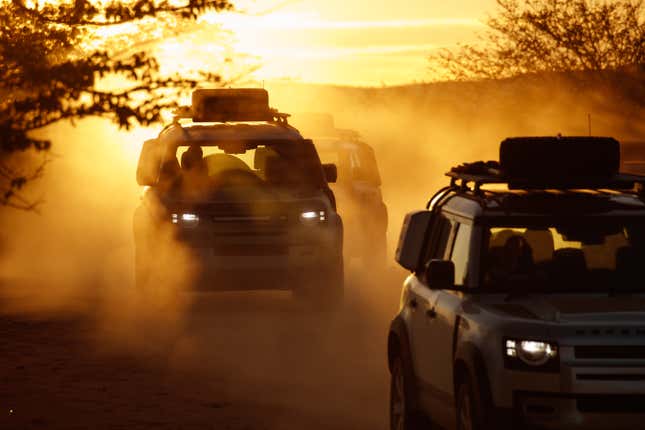
By the time we finished our loop and returned to Opuwo, I was also grateful to be off the road and back to resting speed. And as skeptical as I was about this vehicle at the start, I came away impressed with the Defender’s abilities. And even more so after hearing our test cars were there to survive eight laps of that 400-plus mile tour.
The Defender
The 2020 Land Rover Defender is about to be a main contender in the suddenly revived “off-roady SUV” segment that, for a long time, was pretty much only occupied by the Toyota 4Runner and Jeep Wrangler. Some would argue that the Toyota Land Cruiser and its Lexus equivalent belong there too, along with the Mercedes G-Class, which, fine. The new Ford Bronco, if it’s ever actually launched, will be in the mix as well.

The Defender’s value proposition here is its modern Land Roveriness: lux aura plus earnest capability. I have more personal thoughts about the styling of the new Defender, but I’ll get to them. What’s more interesting is that while this new vehicle’s design is reminiscent of Land Rover’s famous old rough-and-tumble 4x4, when you climb in it and drive around, it becomes clear that the company has evolved beyond its farm and battlefield roots.
This is a practical vehicle you can use for epic expeditions, not a barely-tamed safari rig you can also use get around town if you’re a weirdo. For those weirdos, here’s the deal: The new Defender is the best Discovery ever. For everybody else, it’s a uniquely technologically advanced 4x4 that really is remarkably versatile for long trips that go from pavement to gravel to sand to whatever else the world might reveal to you.
What Shines
The people who designed the new Defender’s interior did a great job making sure all the vehicle’s gimmicks were just as much fun to use as they are to look at. That third front seat you can order works a treat folded down as a center console, and when you do want to seat three abreast, the middle passenger actually has room because the electronic shifter means no linkage where their legs should go. And thanks to the digital rear-view mirror, the driver’s view of what’s behind the vehicle’s never blocked no matter how clogged the cab is.
The touchscreen infotainment system–and Defender’s the first Land Rover to use the company’s dramatically improved interface software–is tucked neatly into a dashboard storage tray. It’s both accessible and cool-looking without disrupting the flow of the driver’s outward view.
The software skin has a lot of soft earth tones and kind of looks like a HUD in Tomb Raider or Unchartered, which of course is perfect. The rest of the vehicle’s controls are organized in a purposeful way that makes them generally easy to access. They all look rugged.
Speaking of ruggedness, you’re probably wondering why you had to scroll so far to get impressions on how the Defender actually behaves off-road. That’s because its defining characteristic in this department is being unremarkable.
When you’re wheeling 10,000 miles from home and 1,000 from a hospital, unremarkable is exactly what you want.
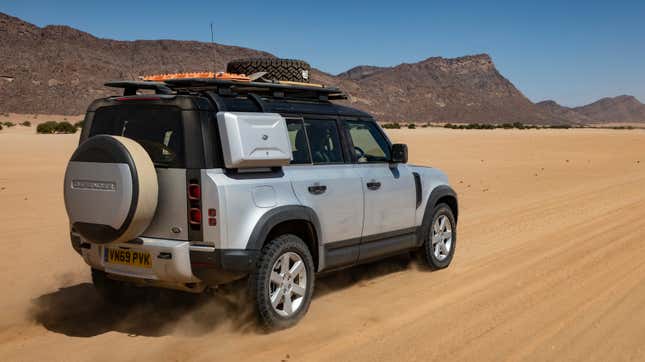
The Defender’s four-wheel independent air-adjustable suspension and sensor-heavy tech suite sound like purist nightmares on paper, but this is the pinnacle of all-terrain technology right now. The vehicle’s hardware and software work so seamlessly together that the driver effort required to shunt this thing down rocks, through deep sand, and across fast-flowing water bodies is really minimal.
While independent suspension is generally considered weaker than solid axles, and it almost always is, the Defender’s critical components are very tough looking and confidence-inspiring. And indeed, didn’t give us anything but successful propulsion all over Kaokoland.
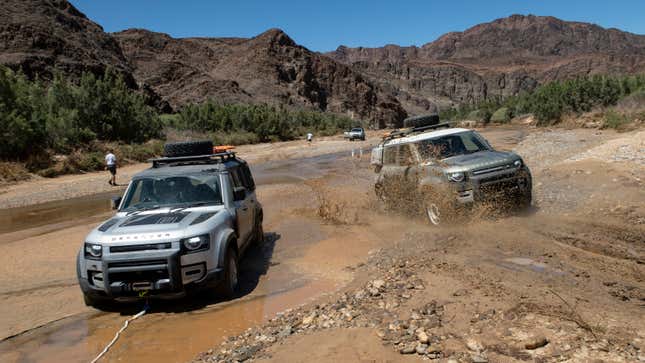
As long as you move slowly and respect the physics of where the vehicle’s weight is resting, a Defender can be pointed at some of Africa’s roughest “road” surfaces and proceed through them with minimal drama. Easier driving, less driver fatigue, more miles covered. There’s your excuse to buy one.
The new Defender is Land Rover’s opportunity to overcome its reputation for dodgy reliability. This rig gets all-new diagnostics, in that it’s diagnosable and updatable remotely via over-the-air connectivity with Land Rover HQ. The company’s spokespeople promise the vehicle’s generally a far cry from the stinkpots the company was cranking out 15 years ago. So far, I’m optimistic that they’re right.
The company’s Chief Commerical Officer Felix Brautigam said 300 Defender prototypes had been used to refine the platform–“more than double” the amount made of any other LR model.
None of the Defenders on my wave suffered any major malfunctions, and I’m pretty sure the only guy who got stuck did it on purpose because he wanted an excuse to use the winch.
What’s Weak
I’ve been staring at photography from this trip, especially shots by the talented Nick Dimbleby, longly for the last few weeks. Especially since the reality of the COVID-19 virus has made the idea of travel seem even more remote and unreachable. But I still, just, can not get excited about the new Defender’s look.
The roof rack, snorkel, all-terrain tires, and tucked winch on our test models in these pics are doing a lot of heavy lifting to execute the safari aesthetic. But under all that, it’s such a disappointingly generic-looking vehicle. I know the edges had to be rounded in the name of fuel economy, but the 2020 Defender is boring in big places and unsuccessfully trying-too-hard in details. The roof windows are tiny. The chequer plate on the hood is plastic. What... is going on with those taillights?
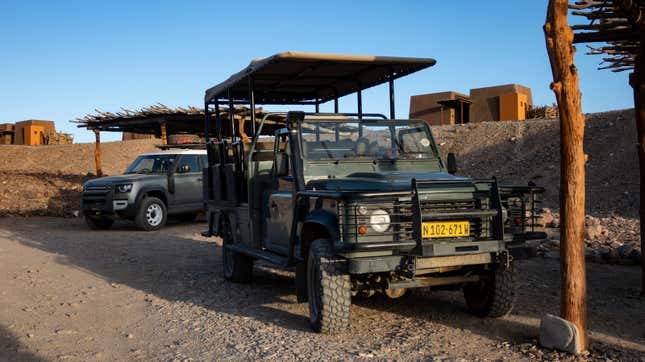
Still, you could go a long way to spicing up the style by wrapping it in Camel Trophy yellow or throwing a rack of round lights across the top of the windshield. Of course, that will eat those mpgs the slippery body’s working for. Anyway, I’m sure some people will dig it.
Behind the wheel, my only real complaint is that there are too many functions shared by a single control. The Defender’s dashboard minimalism looks cool, but it’s annoying how you have to tap several buttons to say if the same click-wheel is going to be adjusting the temperature or changing the drive mode. This is particularly frustrating on an overland expedition when you need to move through modes a lot. And low range activation is just a little button you have to hunt for. Why not make it big and yellow?
Value
As of this writing, the four-door Defender starts at a hair under $50,000. The two-door starts at $65,000 because you can’t order the base four-cylinder steel-wheel spec on it yet.
You can spend hours configuring Defenders on Land Rover’s build-and-price website. But for your reference, the test vehicles we drove were decked right out:
Explorer Pack ($4,800)
- Front Classic Mudflaps
- Rear Classic Mudflaps
- Matte Black Hood Decal
- Spare Wheel Cover
- Wheel Arch Protection
- Raised Air Intake
- Expedition Roof Rack
- Exterior Side-Mounted Gear Carrier
Off-Road pack ($1,345)
- Plug Socket
- Electronic Active Differential
- Torque Vectoring By Braking
- Off-Road Tires
Advanced Off-Road Capability Pack ($735)
- All-Terrain Progress Control (Like off-road cruise control.)
- Terrain Response 2 (Off-road drive modes.)
- Configurable Terrain Response (Make your own drive mode. You want this.)
Front Expedition Protection System ($1,967)
Winch Mounting Kit ($1,975)
...Plus the six-cylinder P400 model’s base price, all brought the ask up to about $73,000.
Running through Land Rover’s build-and-price myself, the cheapest acceptable build I came up with (four-cylinder, steelies, a few off-road options plus heated steering wheel and sunroof) rang up at $57,300.
We don’t know if the four-cylinder is decent to drive, but assuming it is, that price doesn’t seem terrible for the combo of comfort and capability you’re getting here. A Wrangler or 4Runner wouldn’t be nearly as refined or high-tech inside. Plus, they’re both old news.
Deeper On Specs
The 2020 Defender will initially be available in the U.S. with four or six-cylinder gasoline engines and as a two-door “90” model or four-door “110.” In previous iterations of the Defender, those numbers referred to the vehicle wheelbase. Now they’re just names.
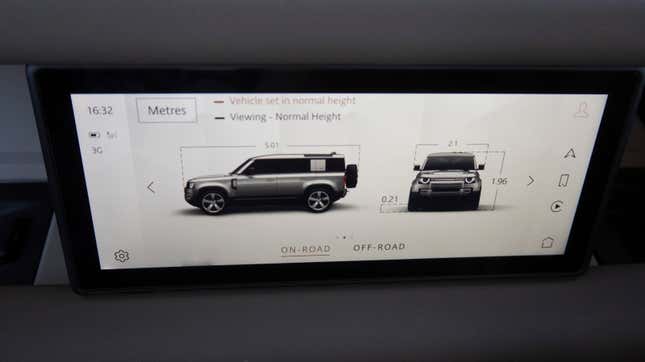
Since my first test was limited to the six-cylinder P400 110 and the diesel, but the diesel probably isn’t coming to the U.S. ever, we’ll focus in on the model that’s going to be most common: the four-door three-liter inline-six.
This engine is going to be the top of the range, and Land Rover claims it’s good for 395 horsepower and 406 lb-ft. I can’t say the vehicle felt particularly swift; it does weigh 5,035 pounds and ours was probably close to the max gross vehicle weight of just under 7,000 all loaded up.
Plus, we were on the knobbier versions of Goodyear DuraTrac tires, which wouldn’t have helped speed at all.
An I6 Defender 110 is rated to tow an impressive 8,201 pounds with a braked trailer and 370 pounds on the roof with the right options.
Unencumbered, 0 to 60 mph is supposed to be able to happen in under six seconds, which is fine.
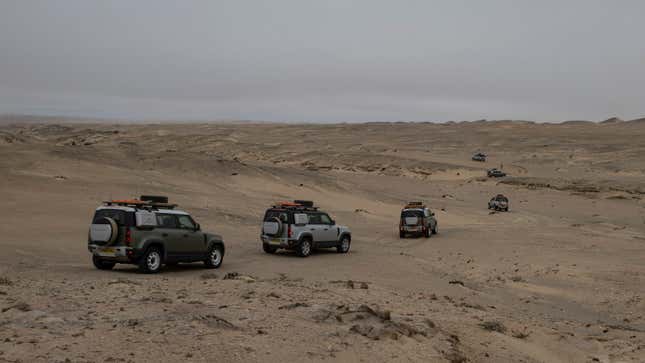
No fuel economy claims have been made and we swapped vehicles too many times to take an estimate on safari, but the fuel tank itself carries just under a healthy 24 gallons.
As far as figures that relate to off-road abilities, Land Rover says the Defender 110 is 197.6 inches long (including a spare tire mounted on the back) with a 118.9-inch wheelbase. It stands at 77.5 inches tall and 82.9 inches wide with its mirrors out.
In the raised off-road height ground clearance is 11.5 inches, water wading max depth is 35.4, and approach/ramp breakover/departure angles are 38 degrees/28 degrees/40 degrees respectively. That should, and does, make for a very limber 4x4 indeed.
Verdict
Namibia’s natural beauty, warm people, and majestic wildlife are relentlessly mind-blowing. And of course, this is my report after only seeing a little slice of the country.
As for the 2020 Land Rover Defender, yes, it’s a genuinely impressive 4x4. It’s a practical, comfortable vehicle that can also traverse some of the roughest terrain I’ve ever encountered. That’s pretty much what Land Rover wants to be, but it’s also antithetical to what makes a classic Defender so much fun.
An old Land Rover makes short trips to the store feel adventurous because there’s noise, smells, lots of wind, and focus required to keep the thing from wandering off into the wrong lane. The jouncing and rattles make you feel like you’re on the Indiana Jones ride at Disney. There are fewer gauges than a lawn tractor has.
That vehicle’s soul is a byproduct of its primitive nature, and that simply cannot be replicated while also optimizing noise, vibration, and harshness for road comfort. In other words, the new Defender doesn’t suck enough to offer the novelty of archaic technology.
All I’m trying to say is: If you want “an old Defender but with better safety features,” the closest new thing is still going to be a Jeep Wrangler. But if you want a great mix of off-road capability, modern tech features, and comfort that gives you the confidence to set off on an indefinite overland expedition at the drop of a pith helmet, the 2020 Defender’s pretty cool.
